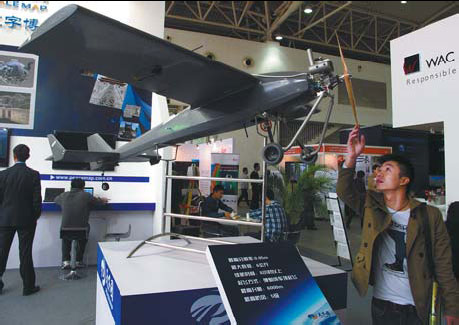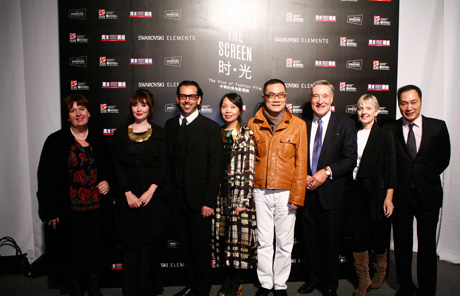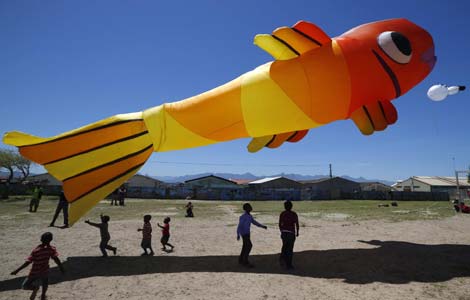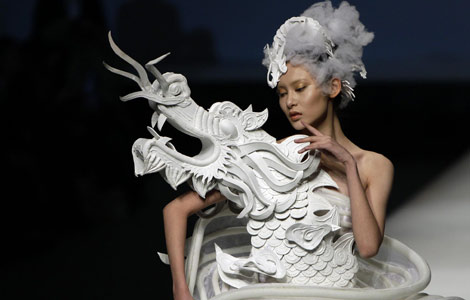Tech advances give museums wow factor
Updated: 2012-11-01 15:34
By Zhang Zixuan (China Daily)
|
||||||||
 |
|
An unmanned aerial vehicle used for aerial photography attracts visitors during the 2012 Museums and Relevant Products and Technologies Expo in Beijing. Zhang Zixuan / China Daily |
China's museums will be getting some bling as they upgrade with many cutting-edge technologies.
A tour of the recent 2012 Museums and Relevant Products and Technologies Expo offers a chance to see some of the industry's future, including digital museums and high-tech repair and security apparatus.
Right out front at the main entrance to Beijing's National Agriculture Exhibition Center, an unmanned aerial vehicle lures a lot of onlookers.
The "eye in the sky" is part of the comprehensive solution of digital museum designed by Beijing Peace Map Technology Co Ltd.
Used for aerial photography for large-scale monuments, historic sites and building complexes, its high resolution can make a 0.05-square-meter area on the ground clearly visible.
"It's stable, low-cost and easy to operate; it can work in extreme environments and weather," says Zhao Bing, marketing director of Beijing Peace Map Technology Co Ltd.
The UAV was historically used in natural disasters such as earthquakes before, Zhao adds. Now it is becoming important for heritage documentation and census-taking.
The company also provides light detection and ranging equipment, or LIDAR, in the air and on the ground.
The airborne sensors can pass through forests and fields, record details on the ground and present them with three-dimensional accuracy, Zhao says. On the ground, the sensors can record precise locations of buildings, monitor their conditions, and craft restoration drawings and repair suggestions.
"By using all these tools, we provide a comprehensive solution from the sky to the ground, from indoor to outdoor and from two dimensions to three dimensions," Zhao says. "A digital museum enables the audience to plan their visiting routes and feel the charm of cultural relics in advance."
"Digital museums can let more people see the treasures that are not open to the public yet," comments Song Xinchao, deputy director of the State Administration of Cultural Heritage and president of China Museum Association. Online viewing also reduces the flow of visitors on the actual site.
The Beijing Horizon Tech Culture Development Co Ltd helps with the construction of a digital museum in a different way. It designs a comprehensive guiding application for every museum that can be downloaded for free at App Store.
"The application includes functions such as exhibit introduction, map and audio tour. You can also send micro-blog data through it," says Zhou Qian, deputy general manager of the company.
In the area of museum security, the First Research Institute of the Ministry of Public Security brings an integrated monitor system platform, which can track activity in a certain area without any blind spots.
"The platform has been piloted in several cities," says Hu Bin, a security technician at the institute. Once it is implemented in museums, he says, State officials can monitor them all at the same time.
Meanwhile, a Chinese calligraphy and textiles cleaning device gets the most attention in the section of the show dedicated to the repair of cultural relics.
Co-designed by the Palace Museum and Zhengzhou Fenghua Industry Co Ltd, the patent product is the only fully automatic cleaning device for paper and textiles in the world.
Paper or textiles are cleaned in a sealed chamber where humidity, water temperature and other variables are controlled by the computer.
The device has now been used in several museums such as the Palace Museum and the Capital Museum.
In the lighting area, the Wac Lighting (Shanghai) Co Ltd demonstrates different lighting systems on old photographs and a Buddha-head statue within a temporarily built gallery.
"Museums tend to use the halogen lamp the most because of its excellent performance on anti-ultraviolet and color rendition," explains Liu Yanjiang, product manager of Wac Lighting Co Ltd. Although the LED lamp is more energy-saving, Liu says, it hasn't coped as well with UV or color, so it is seldom used in museums. But the company has developed a special LED lamp that scores almost as well as the halogen lamp in both areas, Liu says. They are now introducing the LED lamp to museums.
Nearby, the Xi'an Qujiang Chaoren Culture Creativity Co Ltd shocks passers-by with a lifelike statue of Steve Jobs.
The statue's skin is glossy like the real thing, and its eyeballs actually rotate.
"It's made of silica gel," says Hu Zhenhua, planning manager of the company. "The makeup and eyeball making are our patent techniques."
The 80,000 pieces of human hair are planted one by one onto the statue, Hu says. The procedure takes one week to finish.
"Compared to a wax figure, a silica-gel statue can bear both high and low temperatures better," he says.
Now silica-gel statues are widely used in museums to present historic figures and celebrities, as well as to demonstrate specific historic scenes.
zhangzixuan@chinadaily.com.cn











